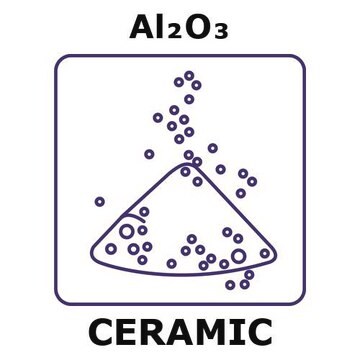702129
Aluminum oxide
nanoparticles, <50 nm particle size (DLS), 20 wt. % in isopropanol
Synonyme(s) :
Alumina
About This Item
Produits recommandés
Forme
dispersion
nanoparticles
Niveau de qualité
Concentration
20 wt. % in isopropanol
Taille des particules
<50 nm (DLS)
pH
8-10
Densité
0.79 g/cm3 at 25 °C
Chaîne SMILES
O=[Al]O[Al]=O
InChI
1S/2Al.3O
Clé InChI
TWNQGVIAIRXVLR-UHFFFAOYSA-N
Vous recherchez des produits similaires ? Visite Guide de comparaison des produits
Catégories apparentées
Description générale
Application
- Elemental analysis of levitated solid samples by microwave-assisted laser induced breakdown spectroscopy.: This study explores the application of aluminium oxide in enhancing the elemental analysis capabilities of laser induced breakdown spectroscopy, providing a novel approach for high precision chemical analysis in analytical chemistry (Alamri AM et al., 2024).
- An ab initio molecular dynamics investigation of the behaviour of amorphous substances in anodic aluminium oxide under electric field.: This research presents a molecular-level understanding of how amorphous substances behave within anodic aluminium oxide structures when subjected to an electric field, offering insights into the material′s stability and reactivity (An Z et al., 2024).
- Alternative nano-lithographic tools for shell-isolated nanoparticle enhanced Raman spectroscopy substrates.: The article discusses the utilization of aluminium oxide in the development of advanced nano-lithographic tools, significantly enhancing the performance of Raman spectroscopy for chemical detection and analysis (Srivastava K et al., 2024).
- Unexpected early loosening of rectangular straight femoral Zweymüller stems with an alumina-reduced surface after total hip arthroplasty-a prospective, double-blind, randomized controlled trial.: This study examines the clinical implications of using aluminium oxide in prosthetic implants, specifically its effect on the longevity and stability of femoral stems in hip arthroplasty (Moret CS et al., 2024).
- Green Synthesis of Aluminum Oxide Nanoparticles Using Clerodendrum phlomidis and Their Antibacterial, Anti-inflammatory, and Antioxidant Activities.: Investigates the biogenic synthesis of aluminium oxide nanoparticles, highlighting their potential in biomedical applications due to their antibacterial, anti-inflammatory, and antioxidant properties (Thanaraj S et al., 2024).
Mention d'avertissement
Danger
Mentions de danger
Conseils de prudence
Classification des risques
Eye Irrit. 2 - Flam. Liq. 2 - STOT SE 3
Organes cibles
Central nervous system
Code de la classe de stockage
3 - Flammable liquids
Classe de danger pour l'eau (WGK)
WGK 1
Point d'éclair (°F)
53.6 °F - closed cup
Point d'éclair (°C)
12 °C - closed cup
Équipement de protection individuelle
Eyeshields, Faceshields, Gloves, type ABEK (EN14387) respirator filter
Faites votre choix parmi les versions les plus récentes :
Déjà en possession de ce produit ?
Retrouvez la documentation relative aux produits que vous avez récemment achetés dans la Bibliothèque de documents.
Les clients ont également consulté
Articles
Hydrogen is one of the most important resources in providing food, fuel, and chemical products for our everyday life. Sustainable catalytic hydrogen production from bioethanol has gained significant attention in recent years due to globally diminishing fossil fuel supplies, which have necessitated the search for new chemical feedstocks.
Among various ceramics, one-dimensional (1-D) piezoelectric ceramics have attracted significant scientific attention for use in energy harvesting.
Electronically, it behaves as a wide band gap (3.2 eV) semiconductor and exhibits memristor properties.2 Optically, TiO2 has high opacity with a very high refractive index3 (>2.4), and it exhibits strong absorbance in the UV range.
White solid-state light can be generated using three different approaches: By employing three diodes that emit red, green and blue light respectively, by using a near-UV LED that excites several phosphors that emit over the complete spectral range, or the third, most widely used alternative entailing down-conversion of a portion of blue LED light to longer wavelengths in such a manner that white light emerges.
Global Trade Item Number
| Référence | GTIN |
|---|---|
| 702129-100G | 4061832820682 |
| 702129-500G | 4061832820699 |
Notre équipe de scientifiques dispose d'une expérience dans tous les secteurs de la recherche, notamment en sciences de la vie, science des matériaux, synthèse chimique, chromatographie, analyse et dans de nombreux autres domaines..
Contacter notre Service technique





